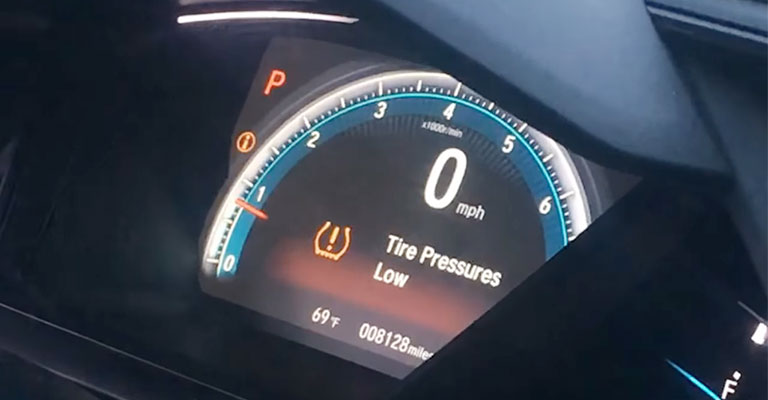To remove the tire pressure light on a Honda Civic you need to reset the Tire Pressure Monitoring System (TPMS)
. Here are some steps you can follow:
- From the home screen select “Settings”.
- Select “Vehicle”.
- Select “TPMS Calibration”.
- Select “Calibrate”.
If your Honda Civic has a touchscreen display you can use the touchscreen to make and enter selections in the Driver Information Interface
. If it doesn’t have a touchscreen display you can use the steering wheel buttons to make and enter selections.Alternatively you can reset the TPMS by pressing and holding the TPMS button until the warning light blinks twice. Another option is to turn off the key and hold down the tire pressure reset button for at least three seconds.It’s important to note that any time you reinflate your tires change a tire or get them rotated the TPMS needs to be recalibrated before it’ll work properly again. Once you start the recalibration process it takes about 30 minutes of driving between 30-65 miles per hour. Then it will stop automatically and your tire pressure monitoring system is good to go.




- Are there any common reasons why the tire pressure light might illuminate in a Honda Civic and how can I identify the specific tire with low pressure?
- What are the recommended steps for checking and adjusting tire pressure on a Honda Civic to resolve the tire pressure light issue?
- Is Tire Pressure Related to the Speed of a Honda Civic?
- If the tire pressure light continues to come on after adjusting the tire pressure what other potential causes should I investigate and when should I consider seeking professional assistance?
- Helpful Resources
Are there any common reasons why the tire pressure light might illuminate in a Honda Civic and how can I identify the specific tire with low pressure?
The tire pressure light in a Honda Civic may illuminate for various reasons. Here are some common reasons why the tire pressure light might come on in a Honda Civic:
- Low tire pressure: If the tire pressure in one or more tires is low the tire pressure light will come on to alert the driver.
- Leaking tire: If one of the tires is leaking air the tire pressure light may come on to warn the driver.
- Faulty tire pressure sensor: If the tire pressure sensor is malfunctioning the tire pressure light may come on even if the tire pressure is normal.
To identify the specific tire with low pressure follow these steps:
- Check the tire pressure in all four tires using a tire pressure gauge. The correct setpoints for your Honda Civic are listed on the driver’s door.
- If the tire pressure in one or more tires is low inflate the tire(s) to the recommended pressure.
- Once the tire pressure has been adjusted reset the tire pressure monitoring system (TPMS) using the instructions in your owner’s manual or by following the steps outlined in online resources.
- Drive the car for about 30 minutes at speeds between 30-65 miles per hour to allow the TPMS to recalibrate.
If the tire pressure light continues to illuminate after following these steps it may be due to a faulty tire pressure sensor or other issues. In this case it is recommended to take the car to a certified Honda mechanic for further inspection and repair.
What are the recommended steps for checking and adjusting tire pressure on a Honda Civic to resolve the tire pressure light issue?
If the tire pressure light is on in your Honda Civic you may need to check and adjust the tire pressure. Here are the recommended steps to resolve the issue:
- Check the recommended tire pressure for your Honda Civic. You can find this information in the owner’s manual or on a sticker located on the driver’s side door jamb.
- Use a tire pressure gauge to check the pressure in each tire. If the pressure is too low add air until it reaches the recommended level. If the pressure is too high release air until it reaches the recommended level.
- After adjusting the tire pressure drive your Honda Civic for at least 30 minutes between 30-65 miles per hour to allow the Tire Pressure Monitoring System (TPMS) to recalibrate.
- If the tire pressure light is still on after recalibrating the TPMS you may need to reset the system. The steps to reset the TPMS may vary depending on the model year and trim level of your Honda Civic. Here are some general steps:
- From the home screen select Settings.
- Select Vehicle.
- Select TPMS Calibration.
- Select Calibrate.
If your Honda Civic does not have a touchscreen display you can use the steering wheel buttons to make and enter selections in the Driver Information Interface.
By following these steps you should be able to check and adjust the tire pressure on your Honda Civic to resolve the tire pressure light issue.
Is Tire Pressure Related to the Speed of a Honda Civic?
Yes, tire pressure is indeed related to the speed of a Honda Civic. Proper tire pressure improves fuel efficiency, handling, and overall performance. To achieve faster speeds, ensure your tires are properly inflated according to the manufacturer’s recommended guidelines. Following these can help optimize your driving experience.
If the tire pressure light continues to come on after adjusting the tire pressure what other potential causes should I investigate and when should I consider seeking professional assistance?
If the tire pressure light continues to come on after adjusting the tire pressure there may be other potential causes to investigate. Here are some possible causes to consider:
- Faulty sensor: The tire pressure monitoring system (TPMS) uses sensors to monitor the air pressure in each tire. If one of these sensors is faulty it may be sending incorrect information to the car’s computer causing the tire pressure light to come on even if the tire pressure is fine.
- Leaking tire: If a tire is leaking air it may cause the tire pressure light to come on even if the pressure has been adjusted. Check each tire for signs of damage or punctures and make sure the valve stem is properly tightened.
- Cold weather: In cold weather the air pressure in your tires can drop causing the tire pressure light to come on. Make sure to check your tire pressure regularly during the winter months.
- Electrical issue: If there is an electrical issue with the car’s computer or wiring it may cause the tire pressure light to come on even if the tire pressure is fine. This is less common than the other causes listed here but it’s still a possibility.
If you have tried adjusting the tire pressure and the tire pressure light continues to come on it may be time to seek professional assistance. A mechanic can diagnose the issue and determine if there is a problem with the TPMS sensors the wiring or another component of the system. It’s important to address the issue promptly as driving with low tire pressure can be dangerous and can cause damage to your tires.
Helpful Resources
- https://www.dchparamushonda.com/how-to-reset-honda-tpms
- https://www.geraldhondacountryside.com/how-to-reset-your-hondas-tire-pressure-monitoring-system/
- https://www.jdpower.com/cars/shopping-guides/how-do-you-reset-tire-pressure-on-a-honda-civic-from-2019
- https://autorideup.com/how-to-make-a-honda-civic-faster/
